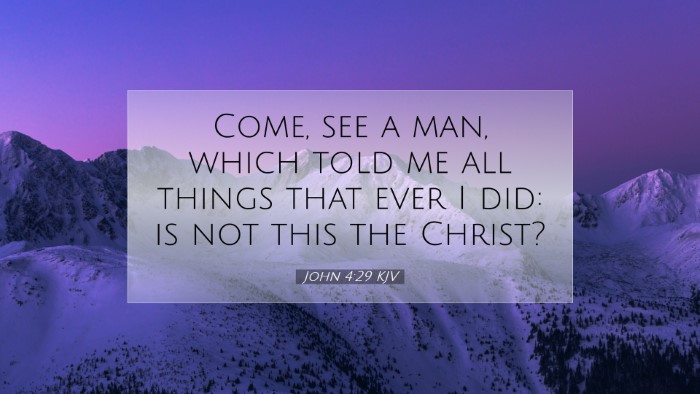Commentary on John 4:29
Verse: "Come, see a man, which told me all things that ever I did: is not this the Christ?"
Introduction
John 4:29 captures a pivotal moment in the Gospel narrative, where the testimony of the Samaritan woman at the well reveals profound theological implications regarding Christ’s identity and mission. This verse serves as a bridge between personal transformation and communal proclamation, urging readers to reflect on the nature of witness in the Christian faith.
Insights from Public Domain Commentaries
Matthew Henry's Commentary
Henry emphasizes the significance of the woman’s declaration as a genuine expression of faith. Her encounter with Jesus prompted her to testify about Him, showcasing the power of personal experience in evangelism. He notes the importance of the words "come" and "see," which suggest an invitation to explore faith doubly; not just to hear of Christ, but to witness Him firsthand.
Moreover, Henry remarks on the woman's transformative experience. Once an outcast due to her past, she becomes a vessel for evangelistic outreach. This reverses societal expectations and highlights Christ's ability to redeem and empower those marginalized by society.
Albert Barnes' Notes on the Bible
Barnes draws attention to the rhetorical question posed at the end of the verse—"is not this the Christ?" This question indicates her understanding of Jesus as the Messiah, which transcends her previous perception of Him as merely a Jew or a prophet. He explains that the woman's statement reflects a burgeoning understanding of Christ's identity as not only a teacher but the promised Savior.
Additionally, Barnes highlights the importance of the invitation to "come and see" as embodying the spirit of evangelism. This phrase evokes an invitation to others, encouraging them not just to accept information but to engage and experience the transformative power of Christ for themselves. It exemplifies the essence of Christian witness whereby personal testimony invites communal participation in faith.
Adam Clarke's Commentary
Clarke’s analysis focuses on the thematic depth of the narrative, interpreting the Samaritan woman's experience as reflective of broader human estrangement from God and the ensuing reconciliation through Christ. He emphasizes that her declaration demonstrates the human response to divine revelation—a spontaneous outbreak of joy and recognition of Jesus’ true nature.
Clarke also notes the significance of the phrase "told me all things that ever I did." This implies a fullness of knowledge that Christ possesses concerning human sinfulness and the yearning for acceptance. It affirms that the woman's insight into her past did not deter Jesus from engaging her; rather, it prompted a personal and revealing encounter.
Theological Implications
The verse also raises important theological themes such as the universality of Christ's message and the radical inclusivity of the Gospel. Even as a Samaritan, the woman receives revelation and communicates it effectively, illustrating that God’s grace extends beyond traditional boundaries.
Application for Pastors, Students, and Theologians
-
Evangelism:
Pastors are encouraged to model the woman’s approach by inviting others to personally engage with Christ. The simplicity of her testimony is a reminder that powerful witness does not require extensive theological training, but rather, a genuine encounter with Christ.
-
Identity of Christ:
Students of theology can delve into the Christological implications of this passage, studying how the Samaritan woman's understanding reflects a pivotal revelation in the unfolding of the New Covenant.
-
The Role of Women in Ministry:
The narrative exemplifies women’s vital role in the early church as key witnesses to the Gospel. Scholars can explore the implications of her testimony on contemporary discussions about gender roles in ministry.
Conclusion
In conclusion, John 4:29 offers rich theological and practical insights into the nature of faith, witness, and the inclusivity of Christ’s message. By exploring this text through the lens of historical commentaries, one gains a deeper appreciation for the immediacy and accessibility of evangelism rooted in personal experience. The encounter of the woman at the well serves as a model for believers, encouraging them to share their experiences, invite others into the journey of faith, and witness the transformative power of Christ in their communities.


